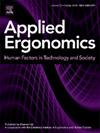将视觉提示与放松音乐、香水和通风相结合,减少乘客晕车:实验研究
IF 3.1
2区 工程技术
Q2 ENGINEERING, INDUSTRIAL
引用次数: 0
摘要
乘用车的自主化、数字化和电动化预计将提高乘员的晕车率。本研究调查了 "防晕车 "系统的有效性,该系统采用动态光刺激来支持纵向运动的视觉感知,并结合轻松的音乐、香水和通风脉冲来提高用户的舒适度。实验设计旨在模拟真实的乘客驾驶过程,53 名受试者作为前排乘客参与了游戏活动。在整个驾驶过程中收集主观晕动病评级,并通过耳内生理测量(包括心率间隔、核心温度和血氧饱和度)监测症状的发展。事后分析表明,晕动病的主观评估没有明显改善。同样,生理测量结果也没有显示出不同条件下的显著差异。不过,与中高易晕车人群相比,测试系统对低易晕车人群更有效。本文章由计算机程序翻译,如有差异,请以英文原文为准。
Combining visual cues with relaxing music, perfume and ventilation to reduce passenger car sickness: An experimental study
The autonomous, digital, and electric transformation of passenger vehicles is projected to elevate the incidence of motion sickness among occupants. This study investigates the effectiveness of an “anti-motion sickness” system that features dynamic light stimuli to support visual perception of longitudinal motion, combined with relaxing music, perfume and ventilation pulses to enhance user wellbeing. In an experimental design aimed at replicating a realistic passenger drive, fifty-three subjects were tested as front passengers engaged in a gaming activity. Subjective motion sickness ratings were collected throughout the drive, and the development of symptoms was monitored through in-ear physiological measurements, including RR-intervals, core temperature, and oxygen saturation. Post hoc analyses indicated non-significant improvement in subjective assessments of motion sickness. Similarly, physiological measurements did not demonstrate any significant difference across conditions. The tested system was however more effective in mitigating car sickness for low susceptible than for mid-to-high susceptible individuals.
求助全文
通过发布文献求助,成功后即可免费获取论文全文。
去求助
来源期刊

Applied Ergonomics
工程技术-工程:工业
CiteScore
7.50
自引率
9.40%
发文量
248
审稿时长
53 days
期刊介绍:
Applied Ergonomics is aimed at ergonomists and all those interested in applying ergonomics/human factors in the design, planning and management of technical and social systems at work or leisure. Readership is truly international with subscribers in over 50 countries. Professionals for whom Applied Ergonomics is of interest include: ergonomists, designers, industrial engineers, health and safety specialists, systems engineers, design engineers, organizational psychologists, occupational health specialists and human-computer interaction specialists.
 求助内容:
求助内容: 应助结果提醒方式:
应助结果提醒方式:


